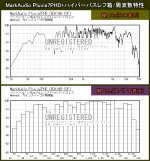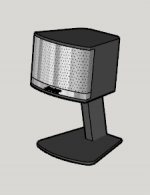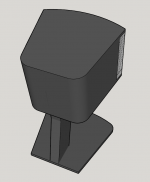The Woden Lance is also a good choice for desktop use. Not a lot of bass but what it has is believable. It uses a single FF85WK driver and is also a very easy build.
I took one of my pairs outside on my porch yesterday, and was using them to scare away the carpenter bees that were hovering. At the same time my neighbors were perfectly happy to have the music, and people passing by on the sidewalk would look over in appreciation. All this from a small speaker that measures 10 3/4" x 5" on the front and 8" deep.
I took one of my pairs outside on my porch yesterday, and was using them to scare away the carpenter bees that were hovering. At the same time my neighbors were perfectly happy to have the music, and people passing by on the sidewalk would look over in appreciation. All this from a small speaker that measures 10 3/4" x 5" on the front and 8" deep.
Mayhem,
Okay, I'll bite. I've got a couple FaitalPro 3fe25 that are sitting in the dash of an old car I'm not using. I just pulled one out, they've seen some wild temperatures in the year they've been in there, so I'm not sure how that's affected them but visually they look new, albeit a bit dusty.
I think I'll make little sealed satellites for them, and will make a couple LR 'subs' to accompany. I have a stash of 6.5" drivers so will use those in separate cabs that I'll tuck in behind or something.
Can you give me some suggestions on what to do? Form is equal to function on this project, so a ported golden ration box or the like are out of the picture. Sealed satellite cube with separate bass cabs tucked in behind are the best aesthetic I can think of right now.
Thanks
aiphex
Desktop surface is valuable, so do what makes sense in your case. My last set of small desktop monitors were 16” tall but only 4.5” wide and deep. This height put the driver of axis with my seated ear height and a slight angle to the baffle. I used that to my advantage with a transmission line enclosure for bass response to around 70hz.
I think you would be advised to consider a single driver full range for desktop because for such close listening it helps for the sound to come from a point source. There are many examples out there. Here's something I built:
Martello Fr88ex
At that size a fullrange driver is one of the best options. You can, however, sometimes improve the sound quality and keep the point source advantages by using a coaxial driver. In many cases the advantage is in the higher dynamics and wider dispersion pattern. It's not always better but it will surely be more expensive.
Hello,
I use Energy RC-Mini's on little stands at my desk. Although I'm happy with them, I'm wondering if I can do better for <$300, or even <$200. I'm looking for small (4.5" driver + tweeter, or fullrange) They don't need to be flattering, just high level of accuracy. I have big waveguide speakers in my listening room and I'm hooked on detailed sound.
I'd like tight bass, but there doesn't have to be much of it. I'm not going to use a sub. The RC-Mini's manage to have a full sound without putting out much bass. I'll make the cabinets from BB and maybe some CLD (brace, panel). I have a miniDSP and multichannel receiver. I've been a long time lurker here, but I'm comfortable with building. I'll make the cabinets with a CNC mill.
Can it be done or should I stick with the speakers I'm using?
Thanks all
aiphex
It's not really clear what improvement you are looking to achieve, because there is no reference on the Energy website to an Energy RC-Mini. So there is nothing to compare these various suggestions against.
If you go the kit route you'll get Jeff Bagby's XO design. Otherwise you're on your own for XO.
BTW, you don't need the kit as Jeff Bagby has documented the Soprano design.
https://www.diyaudio.com/forums/attachments/multi-way/695600d1533550170-various-loudspeaker-design-suggestions-sopranos-write-pdf
File size 749KB
Pluvia 7 or Alpair 7.3, probably the A7msMark Audio all fit into 5 to 13 litre, smaller A5.2 or FF85wk fit into 2-3.5 litre. The original Pluvia 7 can go pretty low, it embarasses some woofers.
What do you think of enclosure FB-10F for the Pluvia Seven HD?
[ DIY ] Hyper Bass-Reflex Type Enclosures (for Single Driver) - DIY - Loudspeaker | Low-end Speaker Craft

That is kind of a joke on 1st look. One clue is that they are usng Sd as a parameter to design it… Sd has nothing to do with a quarter-wave design.
dave
I am looking to build a small'ish desktop 12 litre'ish full range speaker for a friend as a gift. I would like extension down to -3 dB of about 60hz in a ported design.
Based on what I have read from you, it looks like the the Mark Audio CHR 70 or Pluvia Seven HD might be the best driver. I just need a suitable enclosure.
Based on what I have read from you, it looks like the the Mark Audio CHR 70 or Pluvia Seven HD might be the best driver. I just need a suitable enclosure.
The CHR lacis bass. The P7 is very close to the EL70 which makes the P7 (and EL70) are the Mark Audio drivers with the 2nd lowest bass extention potential (only the A10.2 has more potential.
I have a bunch of boxes for the P7 in a paid planset, but i always publish one design for free use.
https://frugal-phile.com/boxlib/P10free/CGR-Plu-Ken7-15-030216.pdf
This is the 13litre alignment which is the optimum size for a miniOnken for this driver.
I have no idea what the F3 is because F3 i don’t pay attention to it since it is something that is meaningless to humans (ref Toole). F6 in the low 50s, F10 40.
dave
I have a bunch of boxes for the P7 in a paid planset, but i always publish one design for free use.
https://frugal-phile.com/boxlib/P10free/CGR-Plu-Ken7-15-030216.pdf
This is the 13litre alignment which is the optimum size for a miniOnken for this driver.
I have no idea what the F3 is because F3 i don’t pay attention to it since it is something that is meaningless to humans (ref Toole). F6 in the low 50s, F10 40.
dave
It's not really clear what improvement you are looking to achieve, because there is no reference on the Energy website to an Energy RC-Mini. So there is nothing to compare these various suggestions against.
The internet is pretty big. Try Google.
Since Klipsch bought Energy (10 years ago?) the website if pretty obsolete. There is an RC-mini and an RC-mini center, I have them until I replaced then with something DIY.
classicalfan - Thanks for pointing that out. Indeed it was a little futile of me to throw out a random speaker that many people surely have never seen, or heard. Once a reputable consumer brand, it seems that since Energy was bought out they've become a shadow of they're former selves. They're poor website is a testament to this. Specs on these speakers may be more easily found under they're current name, the V-mini. I don't think they've developed any new speakers since being bought. Just changed some names.
That is kind of a joke on 1st look. One clue is that they are usng Sd as a parameter to design it… Sd has nothing to do with a quarter-wave design.
Sd being the only parameter used to design/calculate the speaker makes that enclosure type a long try/trial and error for other drivers with different parameters (not to say a lottery). The first speaker looks good so far from the response measurement, the second one, however, does not. The upper bass/low mids got an almost one octave wide notch in the response, around 10dB deep which is obviously a cancellation. That is all but satisfying.
Attachments
If still contemplating the tweeter and woofer approach I can vouch for Scott Sehlin’s Helium Micromonitors. They are unbelievably small but can work near field or do a convincing job at filling a room with sound. They are fairly detailed as well. They were a fun challenge to build as it takes some work to fit everything to such a small box (.04 cu ft). Scott also has designs for some other small speakers as well.
If going full range I can recommend the Dayton PS95-8’s or the Pluvia 7’s. The P7’s are the more balanced of the two. The PS95’s can be a bit shouty with some vocals but piano sounds very convincing with them. I have the PS95’s in some foam core 0.04x mini-karlsonators and the P7’s I ran open baffle with EQ for a bit. I’m curious to get the P7’s into the right box one of these days.
If going full range I can recommend the Dayton PS95-8’s or the Pluvia 7’s. The P7’s are the more balanced of the two. The PS95’s can be a bit shouty with some vocals but piano sounds very convincing with them. I have the PS95’s in some foam core 0.04x mini-karlsonators and the P7’s I ran open baffle with EQ for a bit. I’m curious to get the P7’s into the right box one of these days.
classicalfan - Thanks for pointing that out. Indeed it was a little futile of me to throw out a random speaker that many people surely have never seen, or heard. Once a reputable consumer brand, it seems that since Energy was bought out they've become a shadow of they're former selves. They're poor website is a testament to this. Specs on these speakers may be more easily found under they're current name, the V-mini. I don't think they've developed any new speakers since being bought. Just changed some names.
I looked up the Energy V-mini and it's quite a bit smaller than the suggestions for 2-way kits that have been made for you. The SBA Micro is almost twice the volume of it and the Soprano almost 3 time the volume. Since you have said this is for desktop usage those suggestions might be too big.
The Energy V-minis generally received very favorable reviews and your only real complaint about them is the lack of bass. You also said you have some 6.5" drivers to use for sub woofers. So why not just make those subs and keep using the V-minis. Not sure that you will really gain much with new speakers unless you go up to higher level performance drivers like the Soprano in a larger box.
Last edited:
I'll keep the micromonitors in mind. I have some similar drivers - the aurasound version. A handful of 4 ohm and a handful of 8 ohm black cones. I hate to say it, but I was never crazy about them. I probably did something wrong.
classicalfan - It's true that few suggestions are small enough for my space requirements. The Energy's are quite nice for what they are. Since I have the bug to build, I'm going to make something. Maybe it will be better and maybe it will be worse. I'd like to try to follow the design language of the Bose Companion 3. I've never heard a Bose speaker that I liked, but I do like their designs more than most.
If I go this route then I think I'll try to make the enclosure with kerfed HDF. CLD two layers, use some crafty bracing inside to try to stiffen it up. I know it's not an ideal material, but I can't think of a way to make such a small speaker with MDF or BB. I'll use the FaitalPro 3fe25's I have. Could I get some suggestions on how to go forward on this?
Also should this be moved to fullrange? I'd like to use subs crossed high. ~200hz?
classicalfan - It's true that few suggestions are small enough for my space requirements. The Energy's are quite nice for what they are. Since I have the bug to build, I'm going to make something. Maybe it will be better and maybe it will be worse. I'd like to try to follow the design language of the Bose Companion 3. I've never heard a Bose speaker that I liked, but I do like their designs more than most.
If I go this route then I think I'll try to make the enclosure with kerfed HDF. CLD two layers, use some crafty bracing inside to try to stiffen it up. I know it's not an ideal material, but I can't think of a way to make such a small speaker with MDF or BB. I'll use the FaitalPro 3fe25's I have. Could I get some suggestions on how to go forward on this?
Also should this be moved to fullrange? I'd like to use subs crossed high. ~200hz?
Attachments
Last edited:
It doesn’t seem like there is much point in giving you any more suggestions, since you really haven’t made up your mind about what problem you’re trying to solve.I'll keep the micromonitors in mind. I have some similar drivers - the aurasound version. A handful of 4 ohm and a handful of 8 ohm black cones. I hate to say it, but I was never crazy about them. I probably did something wrong.
classicalfan - It's true that few suggestions are small enough for my space requirements. The Energy's are quite nice for what they are. Since I have the bug to build, I'm going to make something. Maybe it will be better and maybe it will be worse. I'd like to try to follow the design language of the Bose Companion 3. I've never heard a Bose speaker that I liked, but I do like their designs more than most.
If I go this route then I think I'll try to make the enclosure with kerfed HDF. CLD two layers, use some crafty bracing inside to try to stiffen it up. I know it's not an ideal material, but I can't think of a way to make such a small speaker with MDF or BB. I'll use the FaitalPro 3fe25's I have. Could I get some suggestions on how to go forward on this?
Also should this be moved to fullrange? I'd like to use subs crossed high. ~200hz?
Initially, it was the lack of bass from the Energy V-minis. Numerous posters gave you suggestions on a variety of ways to solve that problem. Some were full range and some were 2-way, but they all took peoples time to write.
Now your main desire is to make something with a certain look and without much regard for how it sounds.
My suggestion now is for you to make up your mind and then perhaps write a post for help. Until you do that I don’t see any point in wasting more time responding to you.
classicalfan - I think there was a miscommunication. I never had a problem with bass. I just wanted to know if I could make something 'better', while staying small. A call out for ideas. I did say at one point that form was equal to function for this project. The suggestions certainly helped me understand where the state of the art is within my constraints, since I've been out of the loop for some time. I wouldn't have honed in on the idea of a satellite sub combo without them. Thanks for your suggestions.
Last edited:
And thanks to those who took time to make suggestions even if I didn't directly reply, I did consider.
If I go this route then I think I'll try to make the enclosure with kerfed HDF.
You'll have a very hard time to reach small diameter HDF curves like in your illustration. The fibres are relatively short and it breaks, I don't think it's possible to do that in HDF. Screws in HDF are a problem too, wood screws are easily torn out. If you want to use HDF, use square wood corner pieces and route the curve and a rebade for the HDF to glue onto. I would not recommend to use that material though.
Instead of HDF you could use a wood box as a 'frame' with rounded edges and wood or HDF top and bottom board. For the 4 sides you could use several layers of cardboard, which is flexible enough to follow the curves and still gives you a high stiffness and nice surface. To glue them, just use white (PVCA) glue and 'press' them with a few rubber bands, after drying you can use normal woodworking tools on it. Make it a bit wider than the target height and flush trim route the overlap.
Such enclosures are ideal for a completely different technique and material: 3D printing. They aren't big so a lot of DIY speaker builders with a 3D printer at home could help you there, even a professional 3D printing company should not be very expensive for such enclosures.
A layered plywood enclosure is likely much easier to build than the HDF one too. Build a block of a few layers plywood, drill out the inside with a Forstner drill (you can drill completely through), glue top board on it, screw on the bottom one (with the attached foot), so you can always access the inside and still have no screws visible. The layered plywood is a very nice pattern and looks very good.
Also should this be moved to fullrange?
If this is the direction it is going to take, i can do that if you want.
dave

diyAudio Moderation Team
- Status
- Not open for further replies.
- Home
- Loudspeakers
- Multi-Way
- Small Detailed Desk Speaker


